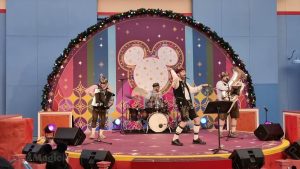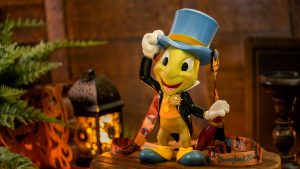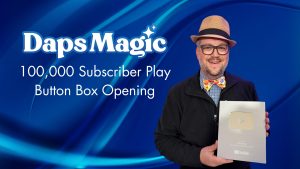The all-new original short Once Upon a Studio takes place at the end of the work day at Walt Disney Animation Studios in Burbank, California, just after the artists, technologists, and storytellers head home. Disney Legend Burny Mattinson—who worked at The Walt Disney Company for 70 years, longer than any other employee—is the last person to leave. When the coast is clear, Mickey Mouse and Minnie Mouse step out of a picture on the wall and ask their animated friends to take an official 100th anniversary portrait. Hand-drawn characters, such as Oswald the Lucky Rabbit and Merlin, intermingle with CG characters, such as Baymax and Rapunzel, as they comically scramble to assemble for the group photo.
If that sounds like an ambitious endeavor… that’s because it is.
Once Upon a Studio is the brainchild of directors Dan Abraham and Trent Correy, who developed the pitch in secret for eight months before presenting it to Disney Animation Chief Creative Officer Jennifer Lee in late 2021. From its inception, they knew the short would be technically complicated—but they always saw the reward in the risk. “Because we built the pitch for so long, the short hasn’t actually changed much,” Correy says. “We changed characters out and tightened up the pacing, but structurally, it’s basically the same as the pitch. We got Bradford Simonsen and Yvett Merino on board as producers very quickly, and Dan and I were lucky enough to be able to write, storyboard, and direct it. So, we jumped into editorial and started making it.”
Their first step was to turn the storyboard panels into a rough cut to assess what they had. “I have a visual effects and live-action background, so I started mapping the milestones of when to line up and hire a crew to shoot the plates; we wanted to start attacking that at the same time we were getting the boards up,” Simonsen says. “And then Yvett and I were chatting every day about this massive cast and how we were going to bring them all back.”
“That alone was another logistical challenge, because we had over 40 of the original voices come back,” Merino explains. “We did everything from recording in-person to recording over Zoom when people were out of out of the state or out of the country. It was such a testament to their experiences with Disney Animation, because the pitch was literally, ‘We’re doing a short to celebrate 100 years. We have a line for you. Would you like to be involved?’ Everyone we reached out to said yes, and they did so without knowing anything.”
Inherently, a project such as Once Upon a Studio requires a skilled team of animators. The directors looked no further than venerated veteran animator and director Eric Goldberg as head of hand-drawn animation. His team included a handful of hand-drawn experts, including Mark Henn and Randy Haycock, in addition to CG animators who had hand-drawn experience; five apprentices specializing in traditional animation; and five returning animation greats who had helped to create some of the Studio’s most beloved characters. Much to Goldberg’s delight, the directors insisted that the hand-drawn animation be done with paper and pencil as much as possible, and that the characters be faithful to their roots. In the end, an estimated 80 percent of the characters featured in the short are hand-drawn.
“This is absolutely the film that had to be made to celebrate the 100th anniversary of Disney and Disney Animation,” Goldberg says. “I think it absolutely fits the bill. I was so excited to work on it and to work with so many of my friends and colleagues. We really tried to honor the past and bring it up to date in the modern day. It’s just been marvelous.”
Andrew Feliciano, a 10-year Disney veteran, was head of CG animation. In all, more than 100 CG characters appear in Once Upon a Studio, hailing from such feature films as Frozen and Wreck-It Ralph and shorts such as Feast and Us Again. Asha, the star of Disney Animation’s upcoming feature film Wish, also makes an early debut in the short film.
“We had the benefit of having people who are able to do both CG and hand-drawn animation,” Feliciano says. “In the scene with Moana and Flounder, for example, Mario Furmanczyk animated both characters. He started by animating Moana, so he had a very clear place to put Flounder. Our shot planning team printed out every single frame for him to put it on paper. Then, he put paper on top of it and he would ‘drop’ Flounder right there.” According to Goldberg, it was especially important to pay attention to eyelines in scenes such as this. “You have to make sure Moana’s eyeline is looking where she is depositing Flounder,” he says. “Another example: Trent animated a penguin with the plate of spaghetti walking past the Mad Hatter. You need him to see it to say, ‘Oh, waiter!’ You really have to make sure that all that timing and eye direction is correct to make it all appear believable.”
Animators from both teams were in constant communication, all in service of the story. And, due to technological advancements, CG character models from Chicken Little to Tangled had to be rebuilt so they would work in the current pipeline.
Making hand-drawn and CG characters look congruous in the same scene was also tricky. “Depending on the needs of a particular scene, we were very, very flexible in terms of what should come first and whatever is going to work best for each particular shot,” Goldberg explains. “When the hand-drawn characters and CG characters interact, there’s a lot of back and forth and coordinating to do—especially if they make contact with something.”
That can be intricate enough for a scene with a handful of characters—let alone 543 of them! Abraham sketched the original idea for the group shot at the end of Once Upon a Studio, which features characters from more than 85 feature films and shorts. Correy then created a “heat map” to determine each character’s placement, Goldberg says. “They both had a huge hand in working out what that shot was going to look like,” he adds. As if the sheer volume of characters wasn’t enough, there were other technical aspects to consider. “The camera’s pulling back, but it’s also rising, so the perspective is actually changing on the groundline as you’re watching the shot reveal,” Goldberg says. “You have to place all of the characters on what we call ‘cards’ so that they are in the right perspective points throughout the entire three-dimensional camera move.”
In the end, all that coordination and dedication paid off—and fans will get to see it for themselves when Once Upon a Studio debuts Sunday, October 15, at 8 p.m. ET/PT as part of ABC’s The Wonderful World of Disney: Disney’s 100th Anniversary Celebration!. “I had a fabulous time working alongside the CG animators whom I’ve been working with for years,” Feliciano says, “and I loved getting to spend time and work very closely with the hand-drawn animators like Eric, Randy, and Mark, as well as the apprentices. It was a really fun experience. The animation reviews and dailies were so much fun, because you never quite knew what you were going to see; it was always going to be a mix of different things. Like, you have Stromboli shaking the vending machines so perfectly and it’s just hysterical and joyful. This short was such a great way to celebrate the 100-year anniversary of the Studio.”





